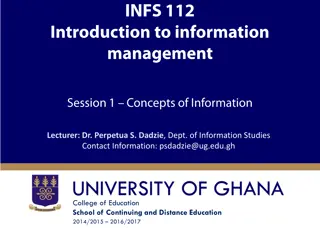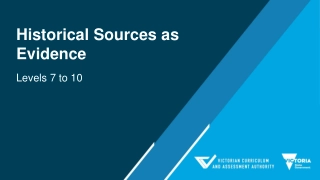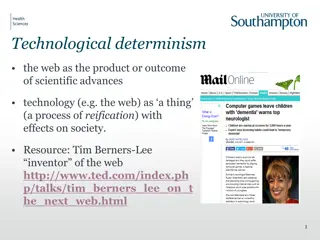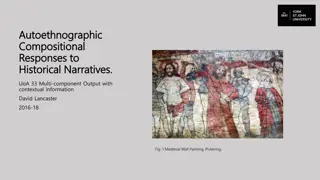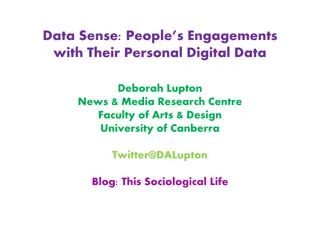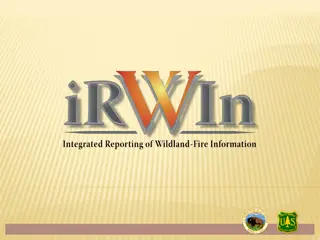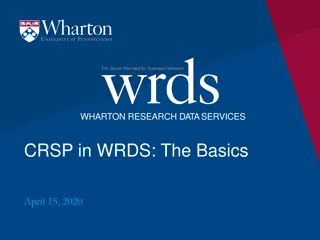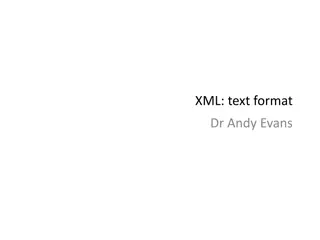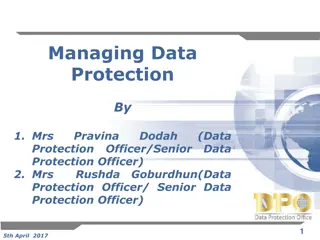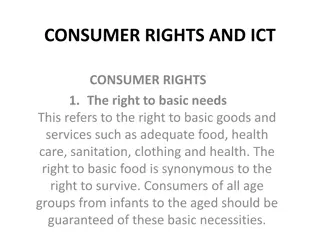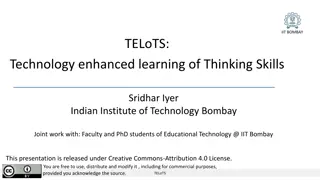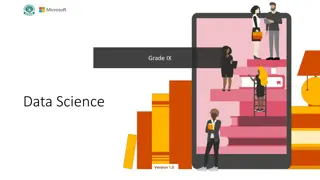Exploring Historical Data Through Information Technology
Delve into the intersection of information technology and historical data with Manfred Thaller at COMHUM 2018. Follow the journey of historical research tools developed to understand demographic behaviors, societal changes, and the impact of agricultural and industrial advancements on population growth in Europe during the 17th and 18th centuries.
- Historical data
- Information technology
- Demographic behavior
- Agricultural advancements
- Population growth
Download Presentation

Please find below an Image/Link to download the presentation.
The content on the website is provided AS IS for your information and personal use only. It may not be sold, licensed, or shared on other websites without obtaining consent from the author. Download presentation by click this link. If you encounter any issues during the download, it is possible that the publisher has removed the file from their server.
E N D
Presentation Transcript
Decoding what the sender did not want to transmit. Information technology and historical data; or something. Manfred Thaller, Br hl June 5th, 2018 Lausanne, COMHUM 2018
Fondly looking at my past - Clio / 1978: Max-Planck-Institute for History, G ttingen Protoindustry research why did Europe s population explode in the 17th/ 18th century? Part of the answer might be, that due to new modes of agricultural as well as proto-industrial production the need for a large labour force increased, so, among others: postnatal population control was relaxed. stigma of illegitimacy was reduced.
Fondly looking at my past - Clio / 1978: Envisaged research instrument for 4 projects: Enriched family reconstitutions . (1) Take registers of births, marriages and depths and create complete genealogical links for village / small down. (2) Take all other sources registers of taxation, protocols of local courts, wills, etc. and connect the references to individuals to the result of step one. (3) Do all sorts of wonderful things.
Fondly looking at my past - Clio / 1978: All sorts of wonderful things (1) Are there differences in the demographic behaviour of families, where the produce mentioned in a probate inventory shows a different stage in the modernization of agricultural technologies? (2) Did the language used in the protocols of court sessions on illegitimate births change synchronously with agricultural / proto industrial development? (3)
Fondly looking at my past - Clio / 1978: Do not think small. Let s build a system that applies all possible computer based tools to all sorts of historical sources.
Fondly looking at my past - Clio / Highly irregular structures Fields of extremely varying length Many fields are missing Groups of fields are frequently, but irregularly often, repeated Hierarchies vary considerably in depths Data bases are usually "large" Data have complex semantics Non decimal currency systems A field might denote a calendar date; unless it should be a text. Sources are frequently ambiguous, vague or contradictory. Databases have to reflect that.
Highly irregular structures data <item> smallest unit, can have more than one datatype simultaneously. <aspect> { basic item, comment item, original item }. <element> array of arbitrarily many items with aspects. [ Similar to an attribute or a terminal node ] <group> an array of arbitrarily many elements plus an array of arbitrarily many groups. [ Similar to a record or a non terminal node ] Yes, that is convenient for hierarchies. No, this is a graph oriented, not a hierarchical data model: items can be of datatype link .
Fondly looking at my past - Clio / Highly irregular structures Fields of extremely varying length Many fields are missing Groups of fields are frequently, but irregularly often, repeated Hierarchies vary considerably in depths Data bases are usually "large" Data bases have complex semantics Non decimal currency systems A field might denote a calendar date; unless it should be a text. Sources are frequently ambiguous, vague or contradictory. Databases have to reflect that.
Vagueness at Item Level Every item has a status. They can be flagged as dubious ? or outstanding ! .
Vagueness at Item Level - Numbers Numbers like 1, 1.5, 12.4.2, 3guilders are intervals: Number x ::= [Min(x)] _ [Max(x)] Numbers can be fuzzified: circa 3guilders less 3guilders _ 5guilders
Vagueness at Item Level Fuzzified Numbers circa [Min] _ [Max] ( [Min] - ( [Min] * 0.10) ) _ ( [Max] + ( [Max] * 0.10) ) circa greater [Min] _ [Max] ( [Min] - ( [Min] * 0.05) ) _ ( [Max] + ( [Max] * 0.10) )
Vagueness at Item Level Fuzzified Numbers <no fuzzifier> [Min] _ [Max] [Min] _ [Max] equal [Min] _ [Max] [Min] _ [Max] circa [Min] _ [Max] ( [Min] - ( [Min] * 0.10) ) _ ( [Max] + ( [Max] * 0.10) ) greater [Min] _ [Max] [Min] _ ( [Max] + ( [Max] * 0.10) ) less [Min] _ [Max] ( [Min] - ( [Min] * 0.10) ) _ [Max] equal circa [Min] _ [Max] ( [Min] - ( [Min] * 0.05) ) _ ( [Max] + ( [Max] * 0.05) ) equal greater [Min] _ [Max] [Min] _ ( [Max] + ( [Max] * 0.05) ) equal less [Min] _ [Max] ( [Min] - ( [Min] * 0.05) ) _ [Max] circa greater [Min] _ [Max] ( [Min] - ( [Min] * 0.05) ) _ ( [Max] + ( [Max] * 0.10) ) circa less [Min] _ [Max] ( [Min] - ( [Min] * 0.10) ) _ ( [Max] + ( [Max] * 0.05) ) equal circa greater [Min] _ [Max] ( [Min] - ( [Min] * 0.025) ) _ ( [Max] + ( [Max] * 0.10) ) equal circa less [Min] _ [Max] ( [Min] - ( [Min] * 0.10) ) _ ( [Max] + ( [Max] * 0.025) )
Vagueness at Item Level Fuzzified Numbers Comparing two numbers A and B - we have to compare [Min(A)] [Max(A)] with [Min(B)] [Max(B)] A greater B [Min(A)] > [Max(B)] A equal greater B [Min(A)] >= [Max(B)] A circa greater B [Max(A)] >= [Min(B)] A equal circa greater B [Max(A)] >= [Max(B)]
Vagueness at Item Level Fuzzified Numbers Arithmetic operations: R = A + B [Min(R)] = [Min(A)] + [Min(B)] and [Max(R)] = [Max(A)] + [Max(B)] R = A - B [Min(R)] = [Min(A)] - [Min(B)] and [Max(R)] = [Max(A)] [Max(B)] R = A * B [Min(R)] = [Min(A)] * [Min(B)] and [Max(R)] = [Max(A)] * [Max(B)] R = A / B [Min(R)] = [Min(A)] / [Min(B)] and [Max(R)] = [Max(A)] / [Max(B)]
Vagueness at Element ( Attribute) Level Every element can have: A visibility in the unit interval [0,1] Alternative views /1=patronymic=3=surname=7=spurious=Johansen/
Vagueness at Group ( Record) Level Every group can have: A visibility in the unit interval [0,1] Alternative views 1=defendant/3=witness/7=spurious$
1948: Claude Shannon Information Source Transmitter Receiver Destination Signal Received Signal Message Message Noise Source
Knowledge Pyramid Wisdom Knowledge Information Data
Data, Information, Knowledge Data can be stored: 22 C . Information are data in a commonly understood context: "In this lecture hall there is a temperature of 22 C". Knowledge allows actions based on an individualized context: For me this means I ll be more comfortable, if I get out of my jacket.
Knowledge Application by cognitive agent Information Interpretation by cognitive agent Data
Data, Information, Knowledge (1) Cognitive agents interpret data within a context common to all agents. In this lecture hall there is a temperature of 22 C . (2) Cognitive agents apply information within a context which is specific to the individual agent. For me this means I ll be more comfortable, if I get out of my jacket.
Data, Information, Knowledge Contemporary Context Knowledge Knowledge Information Signal (Noise) Information 5 5 Data Data 10011 10011
Data, Information, Knowledge Historical Context Knowledge Knowledge Information Signal (Noise) Information Data Data 10011 10011
Data, Information, Knowledge Hist. Research Context Knowledge Knowledge Information Signal (Noise) Information Data Data 10011 10011
Data, Information, Knowledge Hist. Research Context Knowledge ? ? Knowledge Information Signal (Noise) Information Data Data 10011 10011
Data, Information, Knowledge Hist. Research Context Knowledge ? ? Knowledge Information Signal (Noise) Information Data Data 10011 10011
1948: Claude Shannon Information Source Transmitter Receiver Destination Signal Received Signal Message Message Noise Source
The observer / interpreter model Information Source Transmitter Receiver Destination Signal Received .. Signal Message Noise Source Interpreter
The observer / interpreter model Historians do not decode messages. They observe them, to learn about the context of the sender.
The observer / interpreter model Some consequences: Separate data ( uninterpreted ) sources and their interpretation as cleanly as possible. No embedded markup. Texts are sources, just as images and other data types. Develop standoff markup that covers all those data types under a unified model. Accept vagueness in all its appearances.
Vagueness and Fuzziness - general Some of the most important conceptual dimensions Uncertainty I: A precise data point exists; but it is doubtful, whether it is correct - She was probably 25 years old. Uncertainty II: One of a set of data points does apply She was 25 or 35 years old. Vagueness I: A data point is beyond doubt; but it is an interval, rather than a single value She was born in her twenties ( 20 29 years old). Vagueness II: A data point is expressed on a scale, on which a desired operation is undefined She was young. Inconsistency: Contradictory data points are supported - Some say, she was 25 years old; others say, she was 65. Incompleteness: No concrete data point is known, though it must exist Her age is unknown.
Vagueness and Fuzziness - general Assumption: All of these can be supported by three technical solutions (1) Software support for fuzzy numbers. (2) Software support for fuzzy terms and structures. (3) Software support for fuzzy flow control. All three supported by a general fuzzy logic.
Vagueness and Fuzziness - general What does software support mean? (1) Solution on the level of an application e.g. a data base Spurious people of the 13th century , <http://sp13c.someuniversity.terra> means every other application to be developed, ever, has to reinvent the solution. (2) Solution on the level of an application system e.g. a specific data base system like Neo4J means every application realized in another application system to be developed ever, has still to reinvent the solution. (3) Solution on the level of a programming language e.g. C++ or Java means all applications realized with the help of any application system realized with the help of that programming language can easily use it. (4) [ The next level goes beyond the horizon of this presentation. ]
Vagueness and Fuzziness - general fuzziness: fuzzy [fuhz-ee] See more synonyms on Thesaurus.com adjective, fuzz i er, fuzz i est. (3) indistinct; blurred: A fuzzy photograph usually means you jiggled the camera.
Vagueness and Fuzziness - general Fuzziness: A bundle of mathematical, logical and software engineering concepts to handle computations for a number of classes of uncertainty and vagueness, started by: LotfiA. Zadeh: Fuzzy Sets , Information and Control 8 (1965) 338-353.
Crisp sets Elements are contained within a set; or not Set of three images of : M = { , , } Set of all images of : K = { }.
Problematic sets Elements are contained within a set; or not Set of three images of : M = { , , } Set of all images of : K = { , }.
Problematic sets Elements are contained within a set; or not
Problematic sets Elements are contained within a set; or not
Crisp sets in Fuzzy language There is a membership function () defining for every element e within a set U Universe of Discourse whether this element belongs to the set M{}. E.g. (images of , e): 1.0 f r ( , , ) 0.0 f r ( )
Fuzzy Sets Why necessarily one and zero? {0,1} Why not the unit interval? [0,1] I.e.: Truth is not binary, but a degree between 0.0 and 1.0 a.k.a Continuous truth function .
Fuzzy Sets E.g.: (some sculptures) , , , }. U = some sculptures = { (some sculptures) = (1.0, 1.0, 1.0, 0.3) or rather (some sculptures) = (0.8, 0.9, 0.7, 0.3)
Fuzzy Sets Fuzzy Logic I Equality of two sets: A (u) = B (u), u U Union: A B (u) = max[ A (u), B (u)], u U Intersection A B (u) = min[ A (u), B (u)], u U Negation: A (u) = 1 A (u), u U
Fuzzy Sets Fuzzy Logic II Therefore: Collection = { , , , }. Expert1(collection) = (1.0, 1.0, 1.0, 0.3) Expert2(collection) = (0.8, 0.9, 0.7, 0.3) Expert1 Expert2 = (1.0, 1.0, 1.0, 0.3)
Fuzzy Sets Fuzzy Logic III Union: A B (u) = max[ A (u), B (u)], u U But: A AND B min (A, B) Intersection A B (u) = min[ A (u), B (u)], u U But: A OR B max (A, B)



